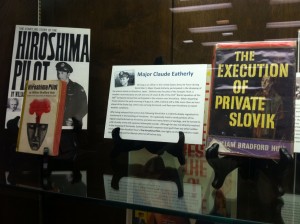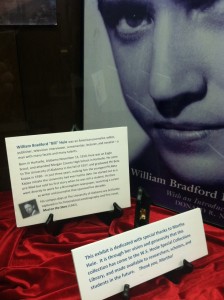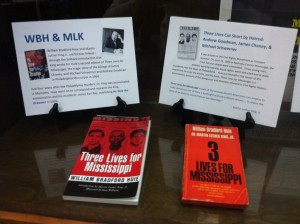By: Jessica Lacher-Feldman
Hoole Library is closed through May 16 for inventory. After we reopen next week, on Monday, May 19, please come in to check out our refreshed displays on the second floor of Mary Harmon Bryant.
This exhibition on the life and work of William Bradford Huie is in honor of Huie and his wife, Martha Hunt Robertson Huie. Martha Huie, who helped bring Huie’s collection to UA, died on May 6, 2014. We wish to honor her legacy.
William Bradford Huie was an American journalist, editor, publishers, television interviewer, screenwriter, lecturer, and novelist — a man with many facets and many talents.
Born in Hartselle, Alabama on November 13, 1910, Huie was an Eagle Scout and attended Morgan County High School in Hartselle. He came to The University of Alabama in the fall of 1927, and graduated Phi Beta Kappa in 1930, making him the youngest Phi Beta Kappa initiate the university had ever had to date. He started out as a pre-Med but sold his first story when he was still a student. He then went directly to work for a Birmingham newspaper, launching a career as a writer and journalist that spanned five decades. His campus days at The University of Alabama are brilliantly captured in his fictionalized autobiography and first novel, Mud on the Stars (1942).
William Bradford Huie was inducted into the United States Navy on April 24, 1943 as an apprentice seaman. Huie served the Seabees as their chief promoter and historian. It was Huie’s goal to ensure that the contributions of the Seabees to the war effort did not go unnoticed. They may not have been fighting battles with the enemy, but they were building roads, buildings, and infrastructure to keep our soldiers safe.
Huie documented the reminiscences of the Seabees as the aide to Admiral Ben Morrell, founder of the Seabees — the Naval Construction Battalions. After interviews, research, and training, Huie published a series of periodical articles and then his first book on these able-bodied men. Huie was said to be perfect for the job of capturing the Seabee story.
The official motto of the Seabees was Construimus, Batuimus — “We Build, We Fight.” The unofficial and popular slogan was Can Do!, and it became the title of Huie’s book on this group of men. Can Do!: The Story of the Seabees was published in 1944 and introduced the Seabees to Huie’s readers on the home front as well as boosted morale and confidence in the troops fighting abroad discussing progress in the American effort.

Huie discusses Major Claude Eatherly in The Hiroshima Plot (1964) William Bradford Huie Collection CT275.E237 H8 1965x
Another one of Huie’s wartime novels focused on Major Claude Eatherly. Serving as an officer in the United States Army Air Force during World War II, Eatherly participated in the dropping of the atomic bomb on Hiroshima, Japan. Eatherly was the pilot of Straight Flush, a weather reconnaissance aircraft and one of the seven B-29s of the 393rd Bomb Squadron of the 509 [Composite] Group that participated in the mission over Hiroshima. When departing Tinian island in the early morning of August 6, 1945, Eatherly left a little more than an hour ahead of the Enola Gay, which was carrying the bomb, and flew over Hiroshima to report on weather conditions.
After having been released from active duty following World War II, Eatherly deeply regretted his involvement in the bombing of Hiroshima. He supposedly tried to send portions of his paychecks back to Hiroshima and also sent many letters of apology, and he turned to petty crime and supposedly attempted suicide. Although he was not directly involved in the dropping of the bomb, Eatherly seemed to express more guilt than any other soldier. Huie’s The Hiroshima Pilot casts light on the accusations made regarding Eatherly and his lifestyle after he left active duty.
Huie also wrote on a variety of issues related to the struggle for Civil Rights. Huie and Martin Luther King Jr. are forever linked — through the brilliant introduction that King wrote for Huie’s second edition of Three Lives for Mississippi, the tragic story of the killings of James Chaney, Michael Schwerner, and Andrew Goodman in Philadelphia, Mississippi in 1964. Just four years after these murders, Dr. King was assassinated in Memphis. Huie went on to correspond and research the King assassination and his murderer, James Earl Ray, publishing He Slew the Dreamer in 1970.
Read more about William Bradford Huie’s life and career by visiting the exhibition. Additionally, The University of Alabama and Ohio State University share portions of Huie’s literary collection. UA’s collection of Huie manuscripts, artifacts, and correspondence are open to researchers, although some restrictions do apply. For more information, please contact archives@ua.edu.
This exhibition is on display for the second time; it was first mounted in honor of Huie’s one hundredth birthday in 2010. Read more about the celebration of his birthday at WBH@100. Both WBH@100 and this exhibition were created by Jessica Lacher-Feldman, who served as the Public and Outreach Services Coordinator and the Curator of Rare Books and Special Collections at Hoole Library. She is currently the Head of Special Collections at Hill Memorial Library at Louisiana State University.




One Response to William Bradford Huie exhibition on display in Hoole lobby